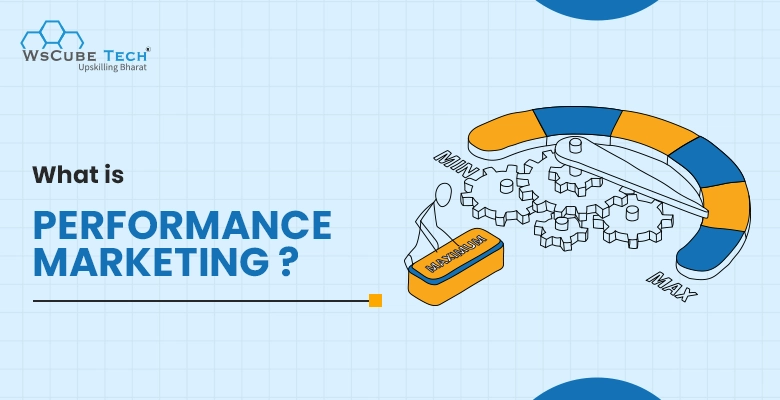Have you ever noticed how brands like Amazon, Swiggy, or Nike seem to show you the right ad at the perfect time?
That’s not luck. It’s the power of performance marketing. Unlike traditional ads that rely on guesswork, this approach focuses on measurable results like clicks, leads, and sales. Businesses pay only when an ad performs, making it one of the most efficient forms of online advertising today.
If you’ve ever wondered what is performance marketing or how companies use it to scale profits without wasting budget, this guide will make everything clear. Let’s understand the performance marketing meaning, how it works, and how even beginners can start using it effectively.
What is Performance Marketing?
Performance marketing is a results-based form of digital marketing where advertisers pay only when a specific action is completed, such as a click, lead, download, or sale. In simple terms, instead of paying just to show your ad, you pay only when the ad actually delivers results.
For example, if you run a fitness app and create a Google Ads campaign, you might pay only when someone installs your app or signs up for a free trial. This ensures every rupee spent is tied to real outcomes, not vague impressions.
The main idea behind performance marketing is accountability. Every campaign can be tracked, measured, and optimized in real time using analytics tools. Marketers can see which ads perform best, which audiences convert more, and how much return they get for every dollar spent.
Because of this data-driven approach, performance marketing has become the backbone of online growth for brands, from small startups to giants like Amazon and Zomato.
How Performance Marketing Works?
Below is how performance marketing works:
1. Set Clear Goals
Every performance campaign starts with defining what you want to achieve — clicks, leads, signups, or sales. These goals decide which platform, ad format, and payment model you’ll use.
For example, an e-commerce store might aim to get more purchases, while an institute may focus on lead generation.
2. Choose the Right Platforms
Next, pick where to run your ads. Common platforms include Google Ads, Meta (Facebook & Instagram), LinkedIn, or affiliate networks. Each platform serves different audiences, so choosing the right one ensures your ads reach potential customers.
3. Create Compelling Ad Creatives
Design visuals, write persuasive ad copy, and create landing pages that motivate users to take action. In performance marketing, creatives play a huge role in improving conversions — they must grab attention and clearly explain your offer.
4. Launch and Track Campaigns
Once your ads go live, every click, impression, and conversion is tracked using tools like Google Analytics, Facebook Pixel, or UTM parameters. This helps you see what’s working and what’s not in real time.
5. Optimize Continuously
Performance marketing is all about testing and improving. Marketers regularly adjust ad copies, targeting, and bids to reduce costs and increase conversions. A/B testing helps find the best-performing version of each ad.
6. Pay Only for Results
Finally, payment happens based on performance — whether it’s cost per click (CPC), cost per lead (CPL), or cost per acquisition (CPA). You invest only in ads that deliver measurable results, ensuring maximum return on ad spend (ROAS).

Key Channels Used in Performance Marketing
These are the different types of performance channels used:
1. Search Engine Marketing (SEM)
Search Engine Marketing (SEM) involves running paid ads on search engines like Google or Bing. Your ad appears when someone searches for a keyword related to your product or service.
Example: A law coaching institute runs Google Ads for “CLAT coaching Online” and pays only when someone clicks the ad.
2. Social Media Advertising
Ads are shown to target audiences on platforms like Facebook, Instagram, LinkedIn, or Twitter (X). You can target by age, interest, or location.
Example: A fashion brand runs Instagram ads to drive people to its online store and pays per click or sale.
3. Affiliate Marketing
Here, you partner with affiliates (bloggers, influencers, or publishers) who promote your product. You pay them a commission only when they bring a sale or lead.
Example: In Amazon affiliate marketing program, the eCommerce giant pays affiliates for every product sold through their referral links.
4. Native Advertising
These are ads that blend naturally into the website or app’s content, making them look less like ads and more like recommendations.
Example: A skincare brand promotes an article titled “5 Ways to Get Glowing Skin” on a beauty blog, with links to its products.
5. Display Advertising
These are visual ads (banners, videos, or pop-ups) that appear on websites, apps, or YouTube. They’re great for creating awareness and driving traffic.
Example: A travel agency runs display ads showing scenic destinations on news websites, paying per click.
6. Email Marketing
Brands send personalized emails to promote products, discounts, or events — and track actions like clicks or purchases.
Example: An e-learning platform like WsCube Tech sends an email campaign offering a 20% discount on digital marketing course and pays only for conversions that come from those emails.
Popular Performance Marketing Models
These are the most popular performance marketing models:
1. CPC (Cost Per Click)
You pay every time someone clicks your ad, regardless of what they do next. It’s great for driving traffic to websites.
Example: If you spend ₹500 and get 100 clicks,
CPC = Total Spend ÷ Total Clicks
₹500 ÷ 100 = ₹5 per click.
This model is common on Google Ads and Facebook Ads.
2. CPM (Cost Per Mille or Cost Per 1,000 Impressions)
You pay for every 1,000 times your ad is shown (even if no one clicks). It’s mainly used for brand awareness campaigns.
Example: If your ad costs ₹200 for 1,000 views, your CPM is ₹200.
Formula: CPM = (Total Spend ÷ Total Impressions) × 1,000
3. CPL (Cost Per Lead)
You pay only when someone submits their details, like signing up for a free demo or filling a form. It’s ideal for service-based or education businesses.
Example: A coaching institute spends ₹10,000 and gets 200 leads.
CPL = ₹10,000 ÷ 200 = ₹50 per lead.
4. CPA (Cost Per Acquisition or Cost Per Action)
You pay only when a specific action is completed, like a purchase, subscription, or download. It directly measures conversions.
Example: An app company pays ₹100 every time someone installs the app.
Formula: CPA = Total Spend ÷ Total Conversions
5. CPS (Cost Per Sale)
Advertisers pay only when a sale happens. This model is commonly used in affiliate marketing.
Example: A clothing brand pays 10% commission to an affiliate for every product sold through their referral link.
6. ROAS (Return on Ad Spend)
It measures how much revenue you earn for every rupee spent on ads — showing campaign profitability.
Formula: ROAS = Revenue Generated ÷ Ad Spend
Example: If you spend ₹5,000 and earn ₹20,000, your ROAS is 4x (or 400%).
Read More Marketing Guides
Benefits of Performance Marketing
These are the top performance marketing benefits:
- Pay Only for Results: You spend money only when a user takes action — like clicking, signing up, or purchasing, ensuring maximum value for every rupee spent.
- Highly Measurable and Trackable: Every ad’s performance can be tracked in real-time, helping you measure clicks, leads, and conversions with complete transparency.
- Cost-Effective: Since you control when and how you pay, it reduces wasted ad spend and ensures better ROI compared to traditional marketing.
- Low Risk, High ROI: The data-driven approach minimizes guesswork and allows you to invest more only in campaigns that perform well.
- Real-Time Optimization: You can adjust targeting, creatives, or bids anytime based on results, helping improve performance continuously.
- Scalable and Flexible: Start small, test campaigns, and scale up as results improve, suitable for both startups and big brands.
- Data-Driven Decisions: Insights from campaigns help refine future strategies, identify top-performing audiences, and improve long-term marketing efficiency.
- Multiple Channel Options: You can run performance campaigns on search, social, email, or affiliate platforms to diversify traffic and conversions.
Challenges in Performance Marketing
- Ad Fatigue: Audiences can lose interest when they see the same ad repeatedly, leading to lower click-through rates. Regular creative updates are essential.
- Click Fraud and Fake Leads: Sometimes bots or fake users click on ads, wasting budget. Using verified ad networks and anti-fraud tools can help prevent this.
- High Competition: With more brands running paid ads, CPC and CPA rates rise. Continuous optimization and targeting refinement are necessary to stay profitable.
- Tracking and Attribution Issues: Tracking user actions across devices and channels can be complex. Using tools like Google Analytics or advanced attribution models helps improve accuracy.
- Compliance and Privacy Rules: Stricter data privacy laws (like GDPR) limit tracking capabilities. Marketers must use ethical tracking practices and maintain user trust.
Performance Marketing Tools
| No. | Tool Name | Description |
| 1 | Google Ads | Runs paid search and display ad campaigns across Google and partner websites for instant visibility and traffic. |
| 2 | Facebook Ads Manager | Creates, manages, and tracks ad campaigns across Facebook and Instagram with detailed targeting and performance insights. |
| 3 | Google Analytics (GA4) | Tracks user behavior, traffic sources, and conversions to measure ad performance and website effectiveness. |
| 4 | SEMrush | All-in-one tool for keyword research, SEO audits, PPC optimization, and competitor analysis. |
| 5 | Ahrefs | Analyzes backlinks, monitors keyword rankings, and finds new growth opportunities for both organic and paid marketing. |
| 6 | Google Tag Manager (GTM) | Simplifies managing and adding tracking codes (like conversion pixels) without needing to edit website code. |
| 7 | HubSpot Marketing Hub | Automates marketing campaigns, tracks leads, and integrates CRM data for improved marketing performance. |
| 8 | Hotjar | Visualizes user behavior through heatmaps and session recordings to optimize landing pages for better conversions. |
| 9 | Google Data Studio (Looker Studio) | Creates customizable and interactive visual reports to present campaign insights and analytics effectively. |
Difference Between Performance Marketing and Digital Marketing
Performance marketing is a part of digital marketing where advertisers pay only when a specific action, like a click, lead, or sale, occurs. It focuses on measurable results and uses data to optimize campaigns for better ROI.
On the other hand, digital marketing is a broader concept that includes all online marketing efforts, paid and organic, such as SEO, social media, and email marketing. While digital marketing builds long-term visibility and brand awareness, performance marketing drives immediate, result-based outcomes.
In short, every performance marketing campaign is digital marketing, but not all digital marketing is performance-based.
How to Create a Performance Marketing Strategy?
Use these tips to create strategy for performance marketing in digital marketing:
1. Define Clear Goals
Start by deciding what you want to achieve: website traffic, leads, app installs, or sales. Your goals will decide the right platforms, ad formats, and performance metrics.
2. Identify Your Target Audience
Know who you’re trying to reach. Study your audience’s age, location, interests, and online behavior. The more specific your targeting, the better your results.
3. Choose the Right Channels
Pick platforms that align with your goals. Use Google Ads for search intent, Meta Ads for awareness and engagement, or affiliate networks for sales-based campaigns.
4. Set a Budget and KPIs
Decide how much you’re willing to spend and what success looks like. Define KPIs like CTR (Click-Through Rate), CPA (Cost Per Acquisition), or ROAS (Return on Ad Spend) to measure performance.
5. Create High-Quality Ad Creatives
Design visually appealing ads and write persuasive copy that clearly communicates your offer. Ensure your landing pages are optimized for fast loading and conversions.
6. Launch and Track Your Campaigns
Run your campaigns and track every click, lead, or purchase using tools like Google Analytics, Facebook Pixel, or UTM tags. Real-time data helps identify what’s working.
7. Optimize and Scale
Analyze your campaign data regularly. Pause underperforming ads, test new creatives (A/B testing), refine audience targeting, and scale campaigns that deliver strong ROI.

Examples of performance marketing
These are a few real-life performance marketing examples that show how brands use it effectively to drive measurable results:
Swiggy App Install Campaigns
Swiggy runs paid ads on platforms like Google and Facebook targeting users in specific cities. It pays only when someone installs the app or places their first order, ensuring ad spend is tied directly to results.
Nike’s Social Media Ads
Nike uses performance-based social media ads to promote limited-edition launches. The brand pays based on conversions, such as product purchases or sign-ups, instead of paying just for impressions.
WsCube Tech Lead Generation
The leading upskilling edtech startup WsCube Tech runs Google Ads to generate leads for demo classes. It pays only when a user fills out the registration form (CPL model), helping them control costs and measure ROI precisely.
E-commerce Retargeting Campaigns
Online stores use retargeting ads to reach users who visited their website but didn’t buy. The advertiser pays only when a user returns and completes a purchase — directly connecting spend to performance.
Career in Performance Marketing
A career in performance marketing is one of the most in-demand paths today. Since every business now wants measurable and result-driven advertising, skilled performance marketers are highly valued across industries.
Anyone with an interest in digital marketing, data analysis, or online advertising can start a career in this field. You don’t need a specific degree; practical knowledge and skills matter more.
Key Skills Required:
- Understanding of Google Ads, Meta Ads, and other ad platforms
- Strong analytical and data interpretation skills
- Creativity for ad copy and visuals
- Budget management and optimization abilities
Popular Job Roles:
- Performance Marketing Executive
- PPC Specialist
- Media Buyer
- Growth Marketer
- Digital Marketing Manager
Average Salary Range (India):
- Entry-level: ₹3–5 LPA
- Mid-level: ₹6–12 LPA
- Senior-level: ₹15 LPA+
Become a highly-paid career by joining WsCube Tech’s full stack digital marketing course.
Future of Performance Marketing
Below is what’s shaping the future beyond 2025:
1. AI and Automation
Artificial Intelligence will handle ad optimization, targeting, and bidding automatically, helping marketers focus on creative and strategic decisions. Platforms like Google and Meta are already using AI to improve campaign performance.
2. First-Party Data Focus
With stricter privacy rules and cookie restrictions, brands will rely more on first-party data (data collected directly from users) to target audiences ethically and effectively.
3. Cross-Platform Attribution
Advanced tracking systems will help marketers see a customer’s full journey — from the first click to final purchase, across devices and channels for better budget decisions.
4. Voice and Visual Search Ads
As smart speakers and visual search tools grow, brands will explore new ad formats optimized for voice commands and image recognition.
5. Personalization at Scale
AI-driven personalization will deliver ads based on user intent, behavior, and preferences in real time, boosting conversions significantly.
6. Integration of Influencer and Performance Marketing
Brands will blend influencer marketing with performance models, paying creators based on conversions or engagement instead of fixed fees.
7. Rise of Performance-Based Video and OTT Ads
Video streaming platforms and OTT apps will offer more performance-focused ad models, where advertisers pay for specific actions taken after watching ads.
FAQs About Performance Marketing
Not directly. SEO is organic, while performance marketing mainly involves paid campaigns that can be tracked and measured instantly.
Google Ads, Facebook & Instagram Ads, LinkedIn Ads, and affiliate networks are among the most popular platforms.
Yes, because you can start with a small budget, test different ads, and pay only when you get real results.
Absolutely. There are many beginner-friendly online courses and tutorials to help you start from scratch.
Using tools like Google Analytics, Facebook Pixel, Google Tag Manager, or specialized trackers like Voluum.
Regularly test new creatives, optimize targeting, monitor data, and scale campaigns that bring high ROI.
There’s no fixed rule. Start small, test different strategies, and increase your budget as you find what works best.
Yes, when they are paid based on results like signups or sales instead of fixed fees.
Explore Our Free Courses


